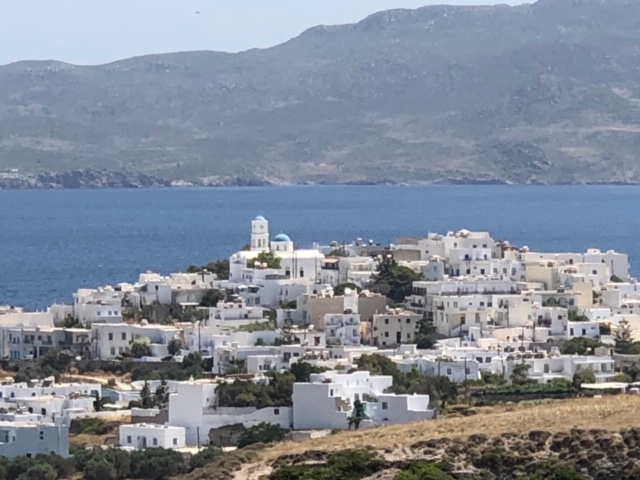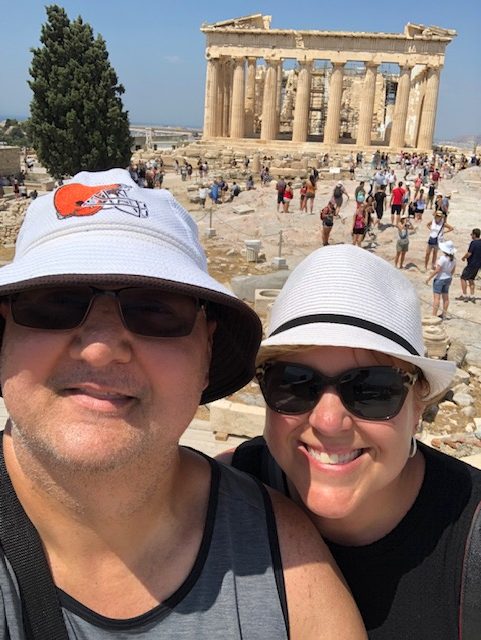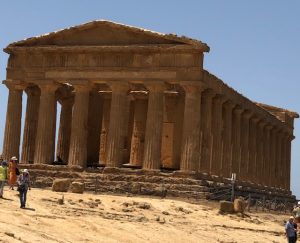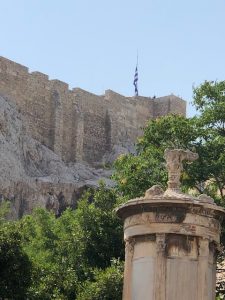Dealing with the Challenges of a Vacation Following My Lung Transplant

Milos, Greece. (Photo by Mark Koziol)
I recently returned from a three-week vacation in Europe. On the trip, my wife, Rebecca, and I visited Poland, Italy, Greece, and Austria.
I was anxious before the holiday and worried about transporting my medications across borders. I thought, “Will I become ill? Will I be able to physically handle the trip?” Various scenarios were running through my head until our departure. In May, I wrote a column detailing how I had increased my workouts to deal with the additional walking I anticipated while on vacation.
The trip began on a sour note as our flight to New York City was canceled several hours before takeoff. Luckily, we live close to the airport and hadn’t yet left home when we learned of the cancelation. We spent the next six hours rescheduling our departure to Poland for the following day.
As a post-operative lung transplant patient, I need to take a large number of pills to avoid rejection and stabilize my electrolytes. Every Sunday morning, I set up my medication regimen for the following week to ensure that I take my medications at the required time. I place my medicines in a seven-day pill container. I have brought them with me on previous domestic flights, but this time, I was carrying my medications across borders. Thankfully, I didn’t encounter any problems with customs or security at international airports. I wasn’t even questioned, and I sighed with relief each time I passed through airport security without incident.
The threat of getting ill while traveling is genuine. I take precautions, but you can’t control everything. On the plane, my wife usually sits down first, whips out the disinfectant wipes, and scrubs our entire seating area and tray tables. I hydrate myself before and during the trip. I stand up periodically and take a walk to avoid edema in my lower extremities.
I believe that an airplane and an airport are possibly some of the most dangerous places for a transplant recipient to be. I used to wear a mask in the airport but haven’t on the last two plane trips. When we are at our destination, I take the same precautions that I do at home. During this trip, I didn’t get ill and felt good overall.
Hot weather was forecast in Italy and Greece. Poland and Austria also had unusually high temperatures. My conditioning was put to the test in Poland as the mercury crept into the 90s. During the three weeks, we had just two days where temperatures fell below 90. Not exactly a recipe for success for a lung transplant recipient.
Thankfully, the heat and humidity do not affect me as much as one might think. As a former college football player, I have performed in extreme temperatures. I believe that staying hydrated and maintaining my physical conditioning has assisted me in overcoming the effects of the weather.
As we had expected, the trip involved a lot of physical activity and a considerable amount of walking. Unfortunately, it appeared that all of the walking was uphill and facing into a slight wind. My wife was concerned about my ability to walk up to the Acropolis to see the Parthenon. The 512-feet climb was via steps and uneven rock. But what would a trip to Greece be without visiting the Acropolis?
We met up with Italian friends in Sicily. They organized a visit to the Valley of the Temples in Agrigento. This was a grueling ascent in mid-90s heat. I took a couple of breaks, but I made it. My wife then broke my heart by telling me that the climb is only about half the length of the trail to the Acropolis.
Our first stop in Athens was the Plaka. While exploring the district, I got my first glimpse of the Acropolis and its daunting height. I saw the Greek flag situated on what was once a belvedere tower from a side street. The view was both wonderful and overwhelming. But I had some time to contemplate the climb as first we were taking a three-day trip to the island of Milos.
The day arrived. The forecast was for temperatures in the upper 90s. I was intimidated to look up at the steep hill I was about to climb. But I focused on the task at hand, controlled my breathing, made several stops, and finally made it to the top! I felt that I had accomplished a massive endeavor, and I am proud to write about it.
***
Note: Pulmonary Fibrosis News is strictly a news and information website about the disease. It does not provide medical advice, diagnosis, or treatment. This content is not intended to be a substitute for professional medical advice, diagnosis, or treatment. Always seek the advice of your physician or other qualified health provider with any questions you may have regarding a medical condition. Never disregard professional medical advice or delay in seeking it because of something you have read on this website. The opinions expressed in this column are not those of Pulmonary Fibrosis News or its parent company, Bionews Services, and are intended to spark discussion about issues pertaining to pulmonary fibrosis.











Robert Wollenberg
Planning is, as you have shown, the key to travel. Problems certainly lurk everywhere and as a fellow lung transplant patient, we know that all too well.
On the other hand, life is for living and if you’ve been given more time you need to use it. You paid attention to your needs and stood atop the Acropolis!! How wonderful ! “Keep on keeping on !!”
Mark Koziol
Hello Robert, thank you so much for reading and commenting. I appreciate your motivation and encouragement. It sounds like you are living life to the fullest as well. Thank you again, Mark.
John & Georgene
Georgene & I wish nothing but the best for you & Rebecca. Glad you had a great trip. You are an inspiration to everyone, not just to people that have had similar health problems.
Mark Koziol
Hello John and Georgene, thnak you for reading and commenting on my column. Best wishes, Mark.
David Stone
Thanks for the article you’re a inspiration to me not to give up
Mark Koziol
Hello David, thank you for reading and commenting on my column. Lets get better quickly. Best wishes, Mark.